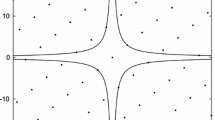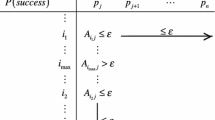Abstract
Tukey depth function is one of the most famous multivariate tools serving robust purposes. It is also very well known for its computability problems in dimensions \(p \ge 3\). In this paper, we address this computing issue by presenting two combinatorial algorithms. The first is naive and calculates the Tukey depth of a single point with complexity \(O\left( n^{p-1}\log (n)\right) \), while the second further utilizes the quasiconcave of the Tukey depth function and hence is more efficient than the first. Both require very minimal memory and run much faster than the existing ones. All experiments indicate that they compute the exact Tukey depth.


Similar content being viewed by others
References
Cuesta-Albertos J, Nieto-Reyes A (2008) The random Tukey depth. Comput Stat Data Anal 52:4979–4988
Donoho DL, Gasko M (1992) Breakdown properties of location estimates based on halfspace depth and projected outlyingness. Ann Stat 20:1808–1827
Edelsbrunner H (1987) Algorithms in combinatorial geometry. Springer, Heidelberg
Hallin M, Paindaveine D, Šiman M (2010) Multivariate quantiles and multiple-output regression quantiles: from \(L_{1}\) optimization to halfspace depth. Ann Stat 38:635–669
Härdle W, Simar L (2007) Applied multivariate statistical analysis. Springer, Heidelberg
Johnson T, Kwok I, Ng R (1998) Fast computation of 2-dimensional depth contours. In: Agrawal R, Stolorz P (eds) Proceedings of the 4th international conference on knowledge discovery and data mining. AAAI Press, New York, pp 224–228
Kong L, Mizera I (2012) Quantile tomography: using quantiles with multivariate data. Stat Sin 22:1589–1610
Kong L, Zuo Y (2010) Smooth depth contours characterize the underlying distribution. J Multivar Anal 101:2222–2226
Koshevoy H, Mosler K (1997) Zonoid trimming for multivariate distributions. Ann Stat 25:1998–2017
Li J, Cuesta-Albertos JA, Liu RY (2012) DD-classifier: nonparametric classification procedure based on DD-plot. J Am Stat Assoc 107(498):737–753
Liu X, Zuo Y (2014a) Computing halfspace depth and regression depth. Commun Stat-Simul Comput 43:969–985
Liu X, Zuo Y (2014b) Computing projection depth and its associated estimators. Stat Comput 24(1):51–63
Mosler K (2013) Depth statistics. In Robustness and Complex Data Structures. Springer, Berlin, pp 17–34
Mosler K, Lange T, Bazovkin P (2009) Computing zonoid trimmed regions of dimension \(d > 2\). Comput Stat Data Anal 53:2500–2510
Mozharovskyi P (2014) Contributions to depth-based classification and computation of the Tukey depth. PhD thesis. University of Cologne
Rousseeuw PJ, Ruts I (1996) Algorithm AS 307: bivariate location depth. J Appl Stat 45:516–526
Rousseeuw PJ, Struyf A (1998) Computing location depth and regression depth in higher dimensions. Stat Comput 8:193–203
Tsay RS (2010) Analysis of financial time series, 3rd edn. Wiley, Hoboken
Tukey JW (1975) Mathematics and the picturing of data. In Proceedings of the international congress of mathematicians on canadian mathematical congress, Montreal, pp 523–531
Yeh A, Singh K (1997) Balanced confidence regions based on Tukey’s depth and the bootstrap. J R Stat Soc Ser B 59:639–652
Zuo YJ (2003) Projection based depth functions and associated medians. Ann Stat 31:1460–1490
Zuo YJ, Serfling R (2000) General notions of statistical depth function. Ann Stat 28:461–482
Acknowledgments
The author thanks Prof. Mosler, K. and Dr. Mozharovskyi, P. for their valuable discussions during the preparation of this manuscript. The author also greatly appreciates two anonymous reviewers for their careful reading and insightful comments, which led to many improvements in this paper. This research is supported by NSFC of China (No. 11601197, 11461029, 71463020), NSF of Jiangxi Province (No. 20161BAB201024, 20151BAB211016), and the Key Science Fund Project of Jiangxi provincial education department (No. GJJ150439).
Author information
Authors and Affiliations
Corresponding author
Ethics declarations
Conflict of interest
I am the sole author of this manuscript. This research involves no human participants and/or animals, and has no conflict of interest.
Rights and permissions
About this article
Cite this article
Liu, X. Fast implementation of the Tukey depth. Comput Stat 32, 1395–1410 (2017). https://doi.org/10.1007/s00180-016-0697-8
Received:
Accepted:
Published:
Issue Date:
DOI: https://doi.org/10.1007/s00180-016-0697-8




